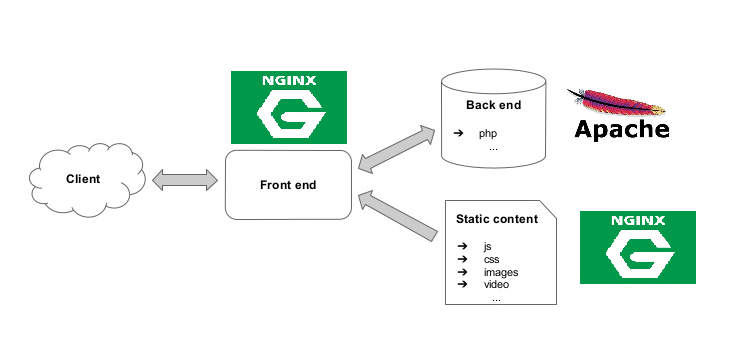What is NGINX Server? How is it Different from Apache Server?
- December 14, 2019
- 0
Apache and Nginx are the top web servers in the business. Collectively, they estimate for almost 50% of the web traffic. Being the two most popular and favorite open source web servers, they work towards the common goal that is to take care of workloads to satisfy the needs of different environments for current operating systems including UNIX and Windows. While Apache is the most popular and already very established in the web server business, Nginx also has its share of success with so many websites and the rate at which it is handling web traffic. It is true that both the web servers can’t be substituted by each other, but they have their own advantages and disadvantages.
What is Nginx Server?
NGINX is open-source software for web serving, caching, load balancing, reverse proxying, media streaming, etc. It began out as a web server created for maximum performance and stability. In extension to its HTTP server capacities, NGINX can also operate as a proxy server for email for POP3, IMAP and SMTP and a reverse proxy and load balancer for TCP, HTTP, and UDP servers.
Nginx with its event-driven, asynchronous architecture transformed how servers work in high-performance contexts and became the most agile web server available. For continued support to the development of NGINX, NGINX Plus was designed for business customers as a commercial product with extra features. Today, NGINX and NGINX Plus both can manage huge concurrent connections, and power more than half of the most active sites on the web.

Image Credit: serverguy.com
NGINX as a Web Server
The intention behind NGINX was to build the fastest web server around and keeping that distinction constant. NGINX beats Apache and other servers in benchmarks measuring web server performance without fail. As the initial release of NGINX however, websites have grown from simple HTML pages to dynamic, multifaceted content. NGINX has evolved and now supports all the elements of the modern Web, comprising WebSocket, HTTP/2, and streaming of multiple video formats. For instance, HDS, HLS, RTMP, etc.
Though NGINX became popular as the fastest web server, the scalable underlying architecture has shown ideal for many web tasks ahead of serving content. As it can manage a high amount of links, NGINX is generally used as a reverse proxy and load balancer to control incoming traffic and distribute it to more inactive upstream servers.
NGINX also is constantly placed within clients and a second web server, to work as an SSL/TLS terminator or a web accelerator. Serving as an agent, NGINX efficiently manages tasks that might slow down your web server, such as compressing and caching content to increase performance or negotiating SSL/TLS. Dynamic sites created utilizing anything from Node.js to PHP, usually deploy NGINX as a content cache and reverse proxy to decrease the load on application servers and obtain the most efficient use of the underlying hardware.
NGINX Plus and NGINX are the best web server and application delivery solutions adopted by high traffic websites, for example, Netflix, Dropbox, and Zynga.
As a software-only open source load balancer, NGINX is cheap and also configurable than hardware load balancers, and is created for modern cloud architectures. NGINX Plus supports on-the-fly reconfiguration and combines with modern DevOps tools for more obvious monitoring.
NGINX is a multi-functional agent. As we said earlier, with NGINX, you can apply the same tool as your load balancer, content cache, reverse proxy, and web server, reducing the cost of tooling and configuration your organization needs to sustain.
NGINX keeps developing. For the past few years, NGINX has been at the forefront of the evolution of the modern Web and has assisted advance the way on everything from HTTP/2 to microservices support. As the development and delivery of web applications proceed to grow, NGINX Plus continues adding features. It allows perfect application delivery, from the newly published support for configuration using an implementation of JavaScript customized for NGINX supporting dynamic modules.
How is Nginx Different from Apache Server?
While both Apache and Nginx are the two major performers in the webserver business crossing 50% of the web traffic over the internet, and at the same time, they are different from each other. Apache is purely an open-source HTTP server, in contrast, Nginx is a high-performance asynchronous web server and Reverse Proxy Server.
Another major difference between the two is the way they both manage client requests. While Apache gives a variety of multiprocessing modules to handle client requests and web traffic, Nginx is intended to handle many client requests together with minimum hardware resources.
A single string is associated with only one connection in the Apache HTTP server, whereas a single thread in Nginx can control multiple connections. All the processes are set in an event loop along with other connections and are executed asynchronously. This process occupies less memory thereby improving performance.
Apache has a multi-threaded architecture that requires scalability. Nginx, on the other hand, supports an asynchronous event-driven method to manage multiple client requests. Its event-driven architecture is so designed to help better performance even under huge traffic.
Apache serves static content using traditional methods and processes dynamic content natively within the web server itself. Nginx, on the other side, requires the capacity to process dynamic content within. Actually, it relies on external processes for execution.
Maintenance, bug fixes, and application development in Apache HTTP server is accomplished and maintained by a community of users from across the world and organized by the Apache Software Foundation. Support of Nginx is supervised by a company of the same name which was established in 2011.
Do you know that installing ApacheBooster cPanel plugin is one technique to improve your page speed performance? It is one of a kind with both Nginx and Varnish doing their best to improve your server on an overall basis. Would you spend a minute to learn more about this awesome performance booster?




